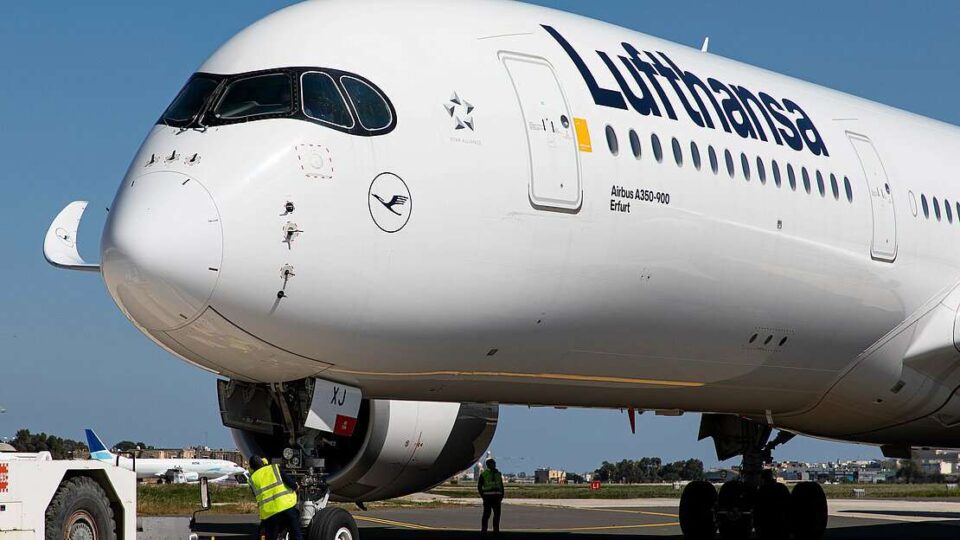Aerospace
Lufthansa turning Airbus A350-900 into a Flying Research Lab

Lufthansa turning Airbus A350-900 into a Flying Research Lab: Lufthansa and several research institutes, converting an Airbus A350-900 into a climate research aircraft to predict the weather even more accurately, analyzing climate changes even more precisely and researching even better how the world is developing.
Read more: British Airways sets its sights on world’s first hydrogen-electric fuel cell flight
Conversion of “D-AIXJ” has begun:
Converting an aircraft into a climate research plane poses major challenges. Lufthansa has chosen the most modern and economical long-haul jet in its fleet – an Airbus A350-900 named “Erfurt” (registration D-AIXJ). In three stages, the “Erfurt” will now become a flying research laboratory.

Courtesy: Lufthansa
In Lufthansa Technik’s hangar in Malta, preparations were made for a complex air intake system below the belly. The aircraft weighs in around 1.6 tons container with measuring equipment. The so-called CARIBIC measurement laboratory, acronym “Civil Aircraft for the Regular Investigation of the Atmosphere Based on an Instrument Container”
The “Erfurt” is expected to take off from Munich at the end of 2021 for its first flight in the service of climate research, measuring around 100 different trace gases, aerosol, and cloud parameters in the troposphere region.
Read More: Airbus demonstrates first fully automatic vision-based take-off
Cooperation between aviation companies and research institutes:
The A350 conversion, which has now been launched, was preceded by an extremely elaborate planning and development phase of about four years involving more than ten companies (in particular Lufthansa, Lufthansa Technik, Airbus, Safran, enviscope, and Dynatec) as well as the Karlsruhe Institute of Technology (KIT) as representative of a larger scientific consortium. The Lufthansa Group has been a reliable partner of climate research since 1994 and since it has equipped several aircraft with special instruments. This is now the first time worldwide on an Airbus A350-900 aircraft.
Read More: Lufthansa Technik to convert Airbus A400M and A321neoLR into patient transport units

Aerospace
Boeing Transfers Rocket Stage to NASA, Paving Way for Human Moon Mission

Boeing has achieved a significant milestone by providing NASA with the second core stage of the Space Launch System (SLS) rocket.
This crucial component, crafted at NASA’s Michoud Assembly Facility (MAF), is set to propel the Artemis II crew into lunar orbit, marking humanity’s return to deep space after a 50-year hiatus.
The monumental Boeing-built rocket stage, the largest element of the Artemis II mission, will embark on a journey aboard the Pegasus barge, traveling 900 miles to NASA’s Kennedy Space Center.
Comparison of two legendary aircraft B777x vs B747 aircraft:Click here
Upon arrival, it will be meticulously integrated with other essential Artemis II components, including the upper stage, solid rocket boosters, and NASA’s Orion spacecraft within the iconic Vehicle Assembly Building. This intricate integration process is a vital step toward the eagerly anticipated Artemis II launch, slated for 2025.
“Boeing-built products helped land humankind on the moon in 1969, and we’re proud to continue that legacy through the Artemis generation,” remarked Dave Dutcher, vice president and program manager for Boeing’s SLS program. “Together, with NASA and our industry partners and suppliers, we are building the world’s most capable rocket and paving the way to deep space through America’s rocket factory in New Orleans.”
NASA, Lockheed Martin Reveal X-59 Quiet Supersonic Aircraft:Click here
The delivery of Core Stage 2 marks a significant achievement in the evolution of the SLS rocket. Towering over 200 feet and powered by four RS-25 engines, this core stage, coupled with two solid-fueled booster rockets, will generate a staggering 8.8 million pounds of thrust. This immense power is crucial to launching Artemis II and future missions into the vast expanse of space.
The SLS rocket stands unparalleled in its capability to transport both crew and substantial cargo to the moon and beyond in a single launch. Its extraordinary capacity will facilitate the delivery of human-rated spacecraft, habitats, and scientific missions to destinations including the moon and Mars, ushering in a new era of space exploration.
-

 Travel1 week ago
Travel1 week agoAir India to Expand US Operations with Three New Routes After a Decade
-

 Travel2 weeks ago
Travel2 weeks agoWhy We Should Avoid These Stamps in a Passport
-

 Airlines1 month ago
Airlines1 month agoInvestigations Reveal Fake Chinese Titanium in Boeing and Airbus Jets
-

 Tech4 weeks ago
Tech4 weeks agoChina’s CATL Plans 1,800-Mile Electric Plane Launch by 2027
-

 Airport3 days ago
Airport3 days agoTop 10 Largest Airports in the World by Size
-

 Aerospace4 weeks ago
Aerospace4 weeks agoChina’s Fighter Jets Turn Wings into Autonomous Drones
-

 Airlines4 days ago
Airlines4 days agoAir India Rolls Out A350s for Delhi-New York JFK and Newark Routes
-

 Defence3 weeks ago
Defence3 weeks agoBoeing Enhances Chinook with New Engines and Block II Upgrades at $96 Million







